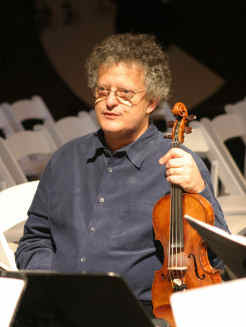Other Links
Editorial Board
- Editor - Bill Kenny
- London Editor-Melanie Eskenazi
- Founder - Len Mullenger
Google Site Search
SEEN
AND HEARD CONCERT REVIEW
Aldeburgh
Festival 2008 (7 and 8) :
Bach, Cage, Birtwistle, Stravinsky, The Arditti
Quartet, The Maltings, Snape, Suffolk 27.6.2008 (AO)
and
Hallaig : the poetry and landscape of Sorley McLean, a film by
Timothy Neat
Aldeburgh Cinema, Suffolk, England
27.6.2008 (AO)
Any Birtwistle premiere is an important event but this was specially
interesting as he hasn’t written all that much for string quartet.
Yet his Pulse Shadows (1996) was so remarkable that the
prospect of more has been eagerly awaited for years. Irvine Arditti
premiered the nine string movements in Pulse Shadows, and was
behind the creation of Tree of Strings. The Arditti Quartet
premiered it at the Wittener Musik Tage in Germany on 27th
April this year. Many in this audience were dedicated enough to
have travelled up from London, and the turnout at Snape was perhaps
equivalent to a sell-out at the Wigmore Hall.

Irvine Arditti
Harrison Birtwistle and the Gaelic poet, Sorley McLean, were
neighbours on the remote Hebridean island of Raasay in the 1970’s.
Birtwistle’s newest work, Tree of Strings refers to a poem by
McLean. “The Tree of Strings” writes McLean, “is in the extremity of
grief”. Yet Birtwistle’s piece isn’t descriptive, for the poem is a
starting point rather than a goal. Like the movements in Pulse
Shadows, the music for string quartet extends the songs, while
existing as separate entities. On first hearing, what stands out
about Tree of Strings is the sense of movement. The violins
and viola act like points on a triangle, while the cello acts as a
bridge between them. There are snatches of quasi-melody, even a
quirkily wayward section like a tipsy Charlie Chaplin trying to
dance. In one of his few comments on the background to the work,
Birtwistle mentioned that his home on Raasay had been near a house
where pipers had come from far away to master the pibroch, bagpipe
music. When strict Calvinists took over, music was banned. Yet as
the film about Sorley McLean demonstrated, that didn’t entirely
suppress private music. McLean’s grandmother sang him ancient Gaelic
songs, and the spirit of song enriched his poetry. Tree of
Strings isn’t explicit, but perhaps its air of ambiguity
connects to that irrepressible impulse. “In the harp of Ruari,
and the pipes of the Patricks, is the loved tree of my talk”
writes McLean, “the serene, lovely music, the white crying music,
the music of my love and talk”.
There are wild passages, such as
when Arditti plays sudden, uninhibited flourishes, but the overall
mood is understated and restrained, changing directions heralded by
subtle intervals. Birtwistle also gives prominence to the cello
part which acts in acerbic counterpoint to the violin, reminiscent
of the cello solo in Ferneyhough’s String Quartet No 5 (see
review) also an
Arditti Quartet premiere. Towards the end, one player at a time leaves the unit, to play on
his own at a distance. Gradually they return, again one by one, and
the ensemble is restored.
Philip Langridge said recently that
Birtwistle writes “
This year in Aldeburgh, minimalist
aphorisms and free spirited “games” have been given full honours, so
it was inevitable that the music of John Cage should feature. His
String Quartet in 4 Parts was written to celebrate silence
without actually using silence, well before the notorious 4’33”.
Far more consciously than Bach or Birtwistle, Cage used mathematical
concepts to create the piece, yet ironically the effect is
surprisingly moving. Perhaps that’s because there are so many ideas
at work that the imagination has lots to play with, and the Arditti Quartet
expressesthem with such agility. Minimalist this may be, but it
articulates by implication, letting the listener fill in the detail
in his or her own mind.
To read an interview with Irvine Arditti in 2006, please click
Here.
Anne Ozorio
Back to Top Cumulative Index Page
